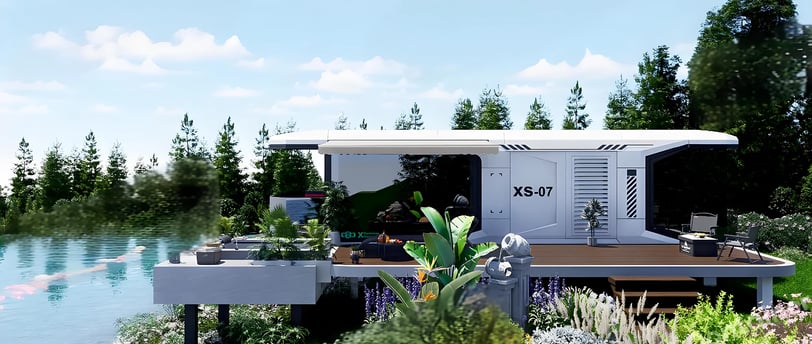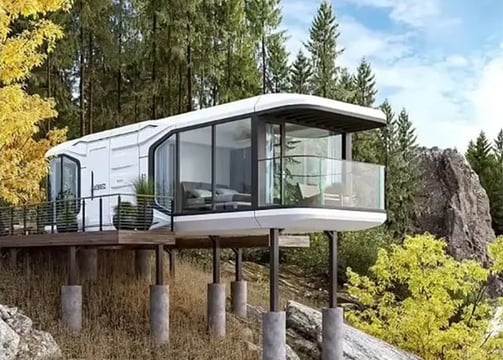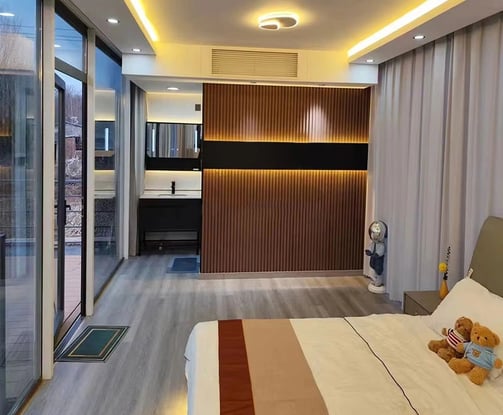Thriving in the Heat: The Benefits of Capsule Houses in Hot Climates
Learn how capsule homes stay cool and energy-efficient in hot climates with cutting-edge design.
SPACE CAPSULE HOUSE
5/26/20252 min read


Capsule houses—also called capsule homes, capsule dwellings, or micro‑pods—are redefining modern living. While their compact footprint raises questions about heat comfort, today’s high‑performance pod living units use smart design and materials to stay cool, efficient, and comfortable—even under blazing sun.
1. Cutting‑Edge Design Features
Advanced Thermal Insulation
By sandwiching walls and roofs with materials like polyurethane foam, EPS/XPS panels, or mineral wool, capsule units create a “cooler bag” effect that blocks external heat. These lightweight yet dense layers trap interior air at a stable temperature, keeping your micro capsule home pleasantly cool without over‑reliance on air conditioning.
Passive Cooling & Natural Ventilation
Strategically placed vents, louvers, and operable windows harness cross‑ventilation and the stack effect to flush warm air out and draw cooler breezes in. This natural airflow system dramatically reduces energy use, helping your capsule dwelling stay comfortable even when outside temperatures soar.
2. Reflective & Radiant‑Barrier Exteriors
Aluminum composite panels—often aviation‑grade or coated with radiant‑barrier finishes—act like a light-colored t‑shirt, reflecting sunlight rather than absorbing it. Combined with solar‑control coatings and light‑reflective paints, these exteriors keep heat at bay, ensuring your pod living space remains cooler during peak sun hours.


3. Premium Materials Built for Sun‑Baked Environments
Polyurethane Foam & Rigid Boards (EPS/XPS): Ideal for walls and ceilings, they deliver high R‑values at low weight.
Mineral Wool Panels: Moisture‑resistant and fire‑safe—perfect for arid, dusty regions.
Low‑E Glazing & Thermal‑Break Frames: Window systems that block radiant heat while flooding interiors with daylight.
Corten or Galvanized Steel & Aviation‑Grade Aluminum: Strong, durable shells that resist warping, corrosion, and UV damage over decades.
4. Real‑World Success Stories
Desert Deployments
In the Middle East and Australian Outback, heat‑resistant capsule homes have kept interiors 10–15°F cooler than ambient temperatures exceeding 110°F (43°C). These modular units reliably deliver sub‑80°F (27°C) comfort, demonstrating their prowess in sun‑scorched landscapes.
Tropical & Humid Settings
Southeast Asian projects report internal temperatures 4–6°C lower than the humid 31–35°C outdoors. Combined with roof vents and louvers, capsule shelters offer respite without constant air‑conditioning, making them a favorite for eco‑resorts and research stations alike.
5. Tackling Common Heat Challenges
Smart Cooling Systems: Integrate solar panels, smart thermostats, and zoned HVAC to balance comfort with energy savings.
Moisture & Condensation Control: Use vapor barriers, dehumidifiers, and meticulous sealing to prevent mold and corrosion in humid heat.
Climate‑Tailored Customizations: Oversized roof overhangs in desert sun belts; adjustable louvers and shade screens in tropical zones; extra‑thick insulation where heat persists.


About
OUR POLICY
Contact
Tel:+86 536 628 1777
Fax:+86 536 628 1777
E_mail:
info@xcontainerhouse.com
XContainerHouse







© 2025. All rights reserved.
